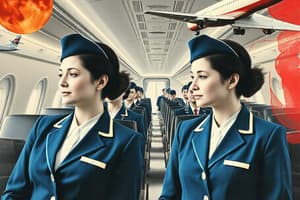Podcast
Questions and Answers
What is the primary purpose of the pre-flight briefing conducted by the cabin crew?
What is the primary purpose of the pre-flight briefing conducted by the cabin crew?
- To ensure passenger safety by conducting pre-flight demonstrations and securing the cabin (correct)
- To review navigation charts
- To calculate fuel requirements
- To communicate with air traffic control
What is the critical phase of flight where the aircraft gains altitude and transitions from ground to flight?
What is the critical phase of flight where the aircraft gains altitude and transitions from ground to flight?
- Taxxing
- Climb
- Boarding
- Take off (correct)
During which phase do pilots perform final checks and communicate with air traffic control?
During which phase do pilots perform final checks and communicate with air traffic control?
- Phase 1: Pre-flight
- Phase 2: Boarding
- Phase 3: Taxxing (correct)
- Phase 4: Take off
What is an important aspect of the pre-flight planning and briefing phase?
What is an important aspect of the pre-flight planning and briefing phase?
What is the primary role of air traffic control during the taxxing phase?
What is the primary role of air traffic control during the taxxing phase?
What is the purpose of the climb phase in aircraft operations?
What is the purpose of the climb phase in aircraft operations?
What is the primary reason for performing cabin checks every 15 minutes during night flights?
What is the primary reason for performing cabin checks every 15 minutes during night flights?
What is the responsibility of the Cabin Instructor during a flight?
What is the responsibility of the Cabin Instructor during a flight?
What should be done with the window slider (raamschuifje) during preparation for landing?
What should be done with the window slider (raamschuifje) during preparation for landing?
What determines the seniority of cabin crew members?
What determines the seniority of cabin crew members?
What is the consequence of a plane being out of balance during takeoff?
What is the consequence of a plane being out of balance during takeoff?
What is the primary purpose of the flight safety demonstration?
What is the primary purpose of the flight safety demonstration?
What is the maximum number of pets allowed in the cabin?
What is the maximum number of pets allowed in the cabin?
What is the purpose of arming the doors and slides?
What is the purpose of arming the doors and slides?
What is the purpose of the crosscheck after the doors are armed?
What is the purpose of the crosscheck after the doors are armed?
What is the primary responsibility of the flight attendants after the safety demonstration?
What is the primary responsibility of the flight attendants after the safety demonstration?
Study Notes
Pre-Flight Phase
- The plane must be in balance to avoid tail tipping or tail strike during takeoff.
- Special category passengers (SCP) include wheelchair users, babies, pets (max 4), service animals, and passengers with bad eyesight or hearing impairments, and unaccompanied minors (under 16).
Safety Briefing
- After boarding and taxi, doors are closed and armed, and the slide is activated.
- The crosscheck control ensures doors are armed correctly.
- Passengers must know emergency procedures, including seatbelts, oxygen masks, life vests, and emergency exit locations.
Phases of Flight
Phase 1: Pre-Flight
- Involves pre-flight planning, briefing, weather assessment, aircraft inspection, and flight plan preparation.
- Pilots review navigation charts, calculate fuel requirements, and conduct safety briefings.
- Cabin crew conducts a pre-flight briefing with the entire crew.
Phase 2: Boarding
- Passengers board the aircraft, and the flight/cabin crew completes pre-flight checks.
- Cabin crew ensures passenger safety by conducting pre-flight demonstrations and securing the cabin for takeoff.
Phase 3: Taxxing
- The aircraft moves on the ground under its own power, guided by the airport tower.
- Pilots perform final checks and communicate with air traffic control.
Phase 4: Takeoff
- The aircraft accelerates along the runway, lifts off, and gains altitude.
- Takeoff is a critical phase where the aircraft transitions from ground to flight.
Phase 5: Climb
- The aircraft ascends to cruising altitude.
- Pilots continue communication with air traffic control.
In-Flight and Preparation for Landing
- Cabin crew performs silent checks every 30 minutes during the day and every 15 minutes at night.
- Preparing for landing involves cleaning up, closing luggage bins, and securing the cabin.
- 10 minutes before landing, the aircraft descends to 10,000 feet, and the backrest, trolleys, and PEDs are secured.
After Landing
- Slides are disarmed, and the door is opened by the ground handler.
- Control is given back to the cockpit, and the aircraft is secured.
Crew Hierarchy
- The captain has command, followed by the most senior first officer, then the cabin instructor (purser on duty), and finally, the cabin crew member in order of seniority based on age and work experience.
Studying That Suits You
Use AI to generate personalized quizzes and flashcards to suit your learning preferences.
Description
Test your knowledge of the essential items to check before takeoff, including seat belts, luggage bins, backrests, and more. Ensure a safe and smooth flight with this comprehensive quiz.



